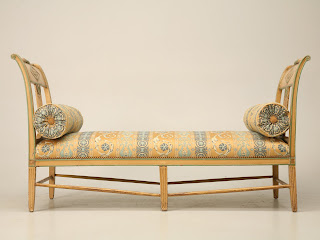
Curved Empire Desk & Bookcase Desk: 94" wide x 25" deep x 29 1/2" tall Bookcase: 136" wide x 46" deep x 105" tall Very unusual 19th century French Empire curved mahogany desk with six drawers, bronze d'ore and patinated bronze stylized cheetahs, and leather top. With matching curved mahogany bookcase with open shelves above 4 doors and 4 drawers decorated with bronze d'ore Empire mounts.
 Louis XV Desk Signed by "H Dasson" 78" wide x 37 1/2" deep x 30 1/4" tall French 19th century Boulle Louis XV Bureau plat with ormolu mounts and gold tooled leather top. Signed by "H Dasson"
Louis XV Desk Signed by "H Dasson" 78" wide x 37 1/2" deep x 30 1/4" tall French 19th century Boulle Louis XV Bureau plat with ormolu mounts and gold tooled leather top. Signed by "H Dasson"
Louis XV Center Table 64 3/4" long x 38" deep x 29 1/2" tall French 19th century Louis XV carved gilt wood center table with contoured marble top
 One of a Pair of Louis XVI Painted Consoles 47 1/2" wide x 20 1/2" deep x 35 1/2" tall Pair 19th century carved and painted Louis XVI consoles with marble tops
One of a Pair of Louis XVI Painted Consoles 47 1/2" wide x 20 1/2" deep x 35 1/2" tall Pair 19th century carved and painted Louis XVI consoles with marble tops
Painted Regence console with marble top 83 1/2" long x 21 1/2" deep x 36" tall Painted Regence console with marble top

Napoleon III Gold Leaf Console 59" wide x 18 1/4" deep x 37 1/2" tall Beautifully carved Napoleon III gilt wood console with breche violet marble top. Circa 1870

Chinoiserie Chest Stamped "Dasson" 55" wide x 23" deep x 38 3/4" tall Exquisite black laquer Chinoiserie Louis XVI commode with bronze d'ore mounts and Amarillo marble top; stamped "Dasson" Circa 1890

















































